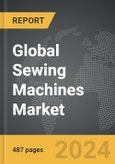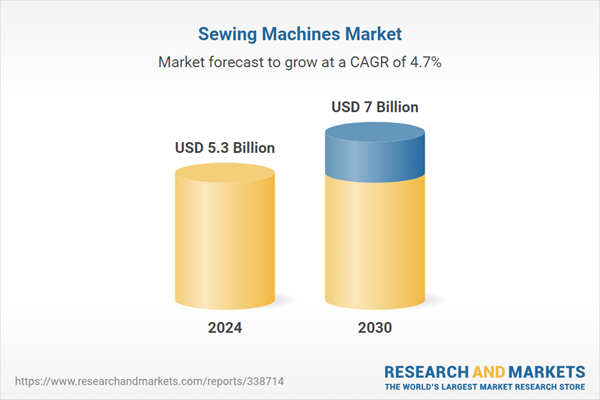The global market for Sewing Machines was valued at US$5.3 Billion in 2024 and is projected to reach US$7.0 Billion by 2030, growing at a CAGR of 4.7% from 2024 to 2030. This comprehensive report provides an in-depth analysis of market trends, drivers, and forecasts, helping you make informed business decisions. The report includes the most recent global tariff developments and how they impact the Sewing Machines market.
Technological advancements have significantly influenced the development and capabilities of sewing machines. Computerized sewing machines, for instance, come with touchscreens, USB ports, and software that allow users to download and execute intricate designs. These machines also include features like automatic tension adjustment and speed control, which simplify complex sewing tasks and reduce the margin for error. In industrial settings, sewing machines are integrated into automated production lines, where they are controlled by robotics and artificial intelligence to maximize productivity and maintain consistent quality. The integration of IoT (Internet of Things) technology allows for real-time monitoring and maintenance, minimizing downtime and optimizing performance. This technological progression has expanded the applications of sewing machines beyond traditional textile manufacturing to include automotive interiors, upholstery, and technical textiles.
The growth in the sewing machine market is driven by several factors, including technological advancements, rising demand from the textile and apparel industries, and increasing consumer interest in DIY projects and crafts. Innovations in sewing machine technology, such as the development of computerized and automated models, have broadened their appeal and functionality, attracting a diverse user base. The textile and apparel industries continue to grow, fueled by fast fashion trends and the increasing demand for customized clothing, which in turn drives the need for efficient and versatile sewing machines. Additionally, the COVID-19 pandemic has spurred a resurgence in home sewing and crafting, as people look for productive and creative outlets while spending more time at home. This trend has boosted sales of household sewing machines and related accessories. Furthermore, the rise of e-commerce has made it easier for consumers to access a wide range of sewing machines and supplies, contributing to market expansion. As a result, the sewing machine market is experiencing robust growth, supported by technological innovations, evolving consumer preferences, and expanding industrial applications.
Segments: Application (Apparel, Non-Apparel); End-Use (Industrial, Household).
Geographic Regions/Countries: World; USA; Canada; Japan; China; Europe; France; Germany; Italy; UK; Spain; Russia; Rest of Europe; Asia-Pacific; Australia; India; South Korea; Rest of Asia-Pacific; Latin America; Argentina; Brazil; Mexico; Rest of Latin America; Middle East; Iran; Israel; Saudi Arabia; UAE; Rest of Middle East; Africa.
The analysts continuously track trade developments worldwide, drawing insights from leading global economists and over 200 industry and policy institutions, including think tanks, trade organizations, and national economic advisory bodies. This intelligence is integrated into forecasting models to provide timely, data-driven analysis of emerging risks and opportunities.
Global Sewing Machines Market - Key Trends & Drivers Summarized
Sewing machines have evolved dramatically since their invention in the 19th century, becoming indispensable tools in both domestic and industrial settings. Modern sewing machines range from simple mechanical models designed for household use to sophisticated computerized versions used in manufacturing and fashion design. These machines offer a variety of functionalities, such as multiple stitch patterns, automatic threading, and embroidery capabilities. Industrial sewing machines are built for heavy-duty use, capable of handling thick fabrics and high-speed stitching, which are essential for mass production in the textile and apparel industries. Advanced features like programmable patterns, digital interfaces, and automated thread cutting enhance efficiency and precision, making sewing machines crucial for high-quality textile production.Technological advancements have significantly influenced the development and capabilities of sewing machines. Computerized sewing machines, for instance, come with touchscreens, USB ports, and software that allow users to download and execute intricate designs. These machines also include features like automatic tension adjustment and speed control, which simplify complex sewing tasks and reduce the margin for error. In industrial settings, sewing machines are integrated into automated production lines, where they are controlled by robotics and artificial intelligence to maximize productivity and maintain consistent quality. The integration of IoT (Internet of Things) technology allows for real-time monitoring and maintenance, minimizing downtime and optimizing performance. This technological progression has expanded the applications of sewing machines beyond traditional textile manufacturing to include automotive interiors, upholstery, and technical textiles.
The growth in the sewing machine market is driven by several factors, including technological advancements, rising demand from the textile and apparel industries, and increasing consumer interest in DIY projects and crafts. Innovations in sewing machine technology, such as the development of computerized and automated models, have broadened their appeal and functionality, attracting a diverse user base. The textile and apparel industries continue to grow, fueled by fast fashion trends and the increasing demand for customized clothing, which in turn drives the need for efficient and versatile sewing machines. Additionally, the COVID-19 pandemic has spurred a resurgence in home sewing and crafting, as people look for productive and creative outlets while spending more time at home. This trend has boosted sales of household sewing machines and related accessories. Furthermore, the rise of e-commerce has made it easier for consumers to access a wide range of sewing machines and supplies, contributing to market expansion. As a result, the sewing machine market is experiencing robust growth, supported by technological innovations, evolving consumer preferences, and expanding industrial applications.
Report Scope
The report analyzes the Sewing Machines market, presented in terms of units. The analysis covers the key segments and geographic regions outlined below.Segments: Application (Apparel, Non-Apparel); End-Use (Industrial, Household).
Geographic Regions/Countries: World; USA; Canada; Japan; China; Europe; France; Germany; Italy; UK; Spain; Russia; Rest of Europe; Asia-Pacific; Australia; India; South Korea; Rest of Asia-Pacific; Latin America; Argentina; Brazil; Mexico; Rest of Latin America; Middle East; Iran; Israel; Saudi Arabia; UAE; Rest of Middle East; Africa.
Key Insights:
- Market Growth: Understand the significant growth trajectory of the Apparel segment, which is expected to reach US$4.4 Billion by 2030 with a CAGR of a 5.0%. The Non-Apparel segment is also set to grow at 4.2% CAGR over the analysis period.
- Regional Analysis: Gain insights into the U.S. market, valued at $891.5 Million in 2024, and China, forecasted to grow at an impressive 5.9% CAGR to reach $2.7 Billion by 2030. Discover growth trends in other key regions, including Japan, Canada, Germany, and the Asia-Pacific.
Why You Should Buy This Report:
- Detailed Market Analysis: Access a thorough analysis of the Global Sewing Machines Market, covering all major geographic regions and market segments.
- Competitive Insights: Get an overview of the competitive landscape, including the market presence of major players across different geographies.
- Future Trends and Drivers: Understand the key trends and drivers shaping the future of the Global Sewing Machines Market.
- Actionable Insights: Benefit from actionable insights that can help you identify new revenue opportunities and make strategic business decisions.
Key Questions Answered:
- How is the Global Sewing Machines Market expected to evolve by 2030?
- What are the main drivers and restraints affecting the market?
- Which market segments will grow the most over the forecast period?
- How will market shares for different regions and segments change by 2030?
- Who are the leading players in the market, and what are their prospects?
Report Features:
- Comprehensive Market Data: Independent analysis of annual sales and market forecasts in US$ Million from 2024 to 2030.
- In-Depth Regional Analysis: Detailed insights into key markets, including the U.S., China, Japan, Canada, Europe, Asia-Pacific, Latin America, Middle East, and Africa.
- Company Profiles: Coverage of players such as AISIN ASIA MIDDLE EAST & AFRICA DMCC, Baby Lock, Bernina International AG, Brother Industries, Ltd., Brother International Corporation and more.
- Complimentary Updates: Receive free report updates for one year to keep you informed of the latest market developments.
Some of the 152 companies featured in this Sewing Machines market report include:
- AISIN ASIA MIDDLE EAST & AFRICA DMCC
- Baby Lock
- Bernina International AG
- Brother Industries, Ltd.
- Brother International Corporation
- Elna International Corp. SA
- Jack Sewing Machine Co., Ltd.
- Janome America, Inc.
- Juki Corporation
- Kaulin Manufacturing Co., Ltd.
- Merrow® Sewing Machine Co.
- Million Special Industries Co., Ltd
- PEGASUS CO., LTD.
- Rimoldi & CF srl
- SEIKO Sewing Machine Co., Ltd.
- Singer Sewing Company
- SVP Worldwide
- TAJIMA Group
- Zhejiang Doso Sewing Machine Co., Ltd.
Tariff Impact Analysis: Key Insights for 2025
Global tariff negotiations across 180+ countries are reshaping supply chains, costs, and competitiveness. This report reflects the latest developments as of April 2025 and incorporates forward-looking insights into the market outlook.The analysts continuously track trade developments worldwide, drawing insights from leading global economists and over 200 industry and policy institutions, including think tanks, trade organizations, and national economic advisory bodies. This intelligence is integrated into forecasting models to provide timely, data-driven analysis of emerging risks and opportunities.
What’s Included in This Edition:
- Tariff-adjusted market forecasts by region and segment
- Analysis of cost and supply chain implications by sourcing and trade exposure
- Strategic insights into geographic shifts
Buyers receive a free July 2025 update with:
- Finalized tariff impacts and new trade agreement effects
- Updated projections reflecting global sourcing and cost shifts
- Expanded country-specific coverage across the industry
Table of Contents
I. METHODOLOGYMII. EXECUTIVE SUMMARY2. FOCUS ON SELECT PLAYERSIII. MARKET ANALYSISSOUTH KOREAARGENTINABRAZILMEXICOREST OF LATIN AMERICAIV. COMPETITION
1. MARKET OVERVIEW
3. MARKET TRENDS & DRIVERS
4. GLOBAL MARKET PERSPECTIVE
UNITED STATES
CANADA
JAPAN
CHINA
EUROPE
FRANCE
GERMANY
ITALY
UNITED KINGDOM
SPAIN
RUSSIA
REST OF EUROPE
ASIA-PACIFIC
AUSTRALIA
INDIA
REST OF ASIA-PACIFIC
LATIN AMERICA
MIDDLE EAST
AFRICA
Companies Mentioned (Partial List)
A selection of companies mentioned in this report includes, but is not limited to:
- AISIN ASIA MIDDLE EAST & AFRICA DMCC
- Baby Lock
- Bernina International AG
- Brother Industries, Ltd.
- Brother International Corporation
- Elna International Corp. SA
- Jack Sewing Machine Co., Ltd.
- Janome America, Inc.
- Juki Corporation
- Kaulin Manufacturing Co., Ltd.
- Merrow® Sewing Machine Co.
- Million Special Industries Co., Ltd
- PEGASUS CO., LTD.
- Rimoldi & CF srl
- SEIKO Sewing Machine Co., Ltd.
- Singer Sewing Company
- SVP Worldwide
- TAJIMA Group
- Zhejiang Doso Sewing Machine Co., Ltd.
Table Information
| Report Attribute | Details |
|---|---|
| No. of Pages | 487 |
| Published | April 2025 |
| Forecast Period | 2024 - 2030 |
| Estimated Market Value ( USD | $ 5.3 Billion |
| Forecasted Market Value ( USD | $ 7 Billion |
| Compound Annual Growth Rate | 4.7% |
| Regions Covered | Global |









